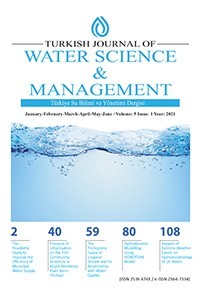Rasyonel Yöntemin Rasyonel Olmayışı ve İyileştirilmesi
Rational Method Irrationality with Rectification
Drainage area, peak discharge, rainfall intensity, rational method slopes,
___
- Al-Zahrani, M. K., Al-Harthi, S. G., Hawsawi, H. M., Al -Ammawi, F. A., Theban, M. S., Khiyami, H. A., Bulkhi, A., Şen, Z. (2007). Potential Flood Hazard in Wadi Baish Southwest, Saudi Arabia. Saudi Geological Survey Confidential Report, 216 pp.
- Bayazıt, M., Önöz, B. (2008). Taşkın ve kuraklık hidrolojisi, Nobel Yayınevi, ISBN: 978-605-395-142-1, İstanbul, Ekim.
- Chow, V., Maidment, D., Mays, L. (1988). Applied hydrology: McGraw-Hill, New York, 572 P.
- Costa, J.E. (1987). A comparison of the largest rainfall-runoff floods in the United States with those of the People’s Republic of China and the world in W.H. Kirby, S.Q. Hua and L.R. Beard, eds, Analysis of extraordinary flood events: Journal of Hydrology, v. 96, p. 101–115.
- Hjelmfelt, Jr. A. T. (1991). Investigation of curve number procedure. Journal of Hydrologic Engineering, ASCE 117(6): 725–737.
- Kirpich, Z. P. (1940). Time of concentration of small agricultural watersheds. Civil Engineering 10 (6), 362. The original source for the Kirpich equation.
- Kadioglu M, Şen Z. (2001). Monthly precipitation–runoff polygons and mean runoff coefficients. Hydrological Sciences Journal 46(1): 3–11.
- Linsley, R.K. (1982). Rainfall - runoff models - an overview. In Proceedings of the International Symposium on Rainfall–Runoff Relationship, Singh VP (ed.). Water Resources Publications: Littleton, CO.
- Maidment, D.R. (1993). Handbook of Hydrology. McGraw-Hill, Inc., New York.
- Omolayo, A. S. (1993). On the transformation of areal reduction factors for rainfall frequency estimations. Journal of Hydrology, 145, 191-205.
- Pilgrim, D. H., Cordery, I. (1993). Flood Runoff. Handbook of Hydrology, Maidment DR (ed.). McGraw-Hill: New York; 9.1–9.42.
- Ponce, V. M., Hawkins, R. H. (1996). Runoff curve number: has it reached maturity? Journal of Hydrologic Engineering, ASCE 1(1): 11–19.
- Sirdaş, S., Şen, Z. (2007). Determination of Flash Floods in Western Arabian Peninsula Journal of Hydrologic Engineering , ASCE, Vol. 12 , No. 6, 676-681.
- Şen, Z., Al-Suba’i K. (2002). Hydrological considerations for dam siting in arid regions: Saudi Arabia study. Hydrological Sciences Journal, 47(2) 173-186.
- Şen, Z. (2008). Wadi Hydrology. Taylor and Francis Group, CRC Press, Boca Raton, 345 pp.
- Şen, Z., (2010). Fuzzy Logic and Hydrological Modeling. Taylor and Francis Group, CRC Press Publishers, 340.
- Soil Conservation Service (SCS). (1971). National Engineering Handbook, Section 4: Hydrology. USDA: Springfield, VA
- Soil Conservation Service (SCS). (1986). Urban Hydrology for Small Watersheds, Technical Report 55. USDA: Springfield, VA.
- ISSN: 2536-474X
- Başlangıç: 2017
- Yayıncı: Tarım ve Orman Bakanlığı Su Yönetimi Genel Müdürlüğü
Akarçay Havzası’nda Su Çerçeve Direktifine Göre İlk Biyolojik İzleme: Fitoplankton ve Fitobentoz
Nilsun DEMİR, Tolga ÇETİN, Caner GÖK, Müge ŞANAL
Türkiye için İklim Değişikliği Projeksiyonları: Üç Model ve İki Senaryo
Mesut DEMİRCAN, Hüdaverdi GÜRKAN, Osman ESKİOĞLU, Hüseyin ARABACI, Mustafa COŞKUN
Kapsamlı Bir Kuraklık Yönetim Planı Oluşturulması İçin Gerekli Araçlar - Konya Havzası Çalışması
Mustafa Berk Duygu, Bilal Kirmencioğlu, Maruf Aras
İklim Değişikliğine Adaptasyon Kapsamında Sektörel Etki Analizi Metodolojisi
Maruf Aras, Ayşegül Tanık, Ayşe Yıldırım Coşgun, Seda Abat, Mehmet Aşkıner
Amerika Birleşik Devletleri’ndeki Minimum Akım Trendleri
Rasyonel Yöntemin Rasyonel Olmayışı ve İyileştirilmesi
Alternati̇f Reservuar Haci̇m Deği̇şi̇mleri̇ni̇n Taşkın Kontrolu Açısından Değerlendi̇rilmesi
